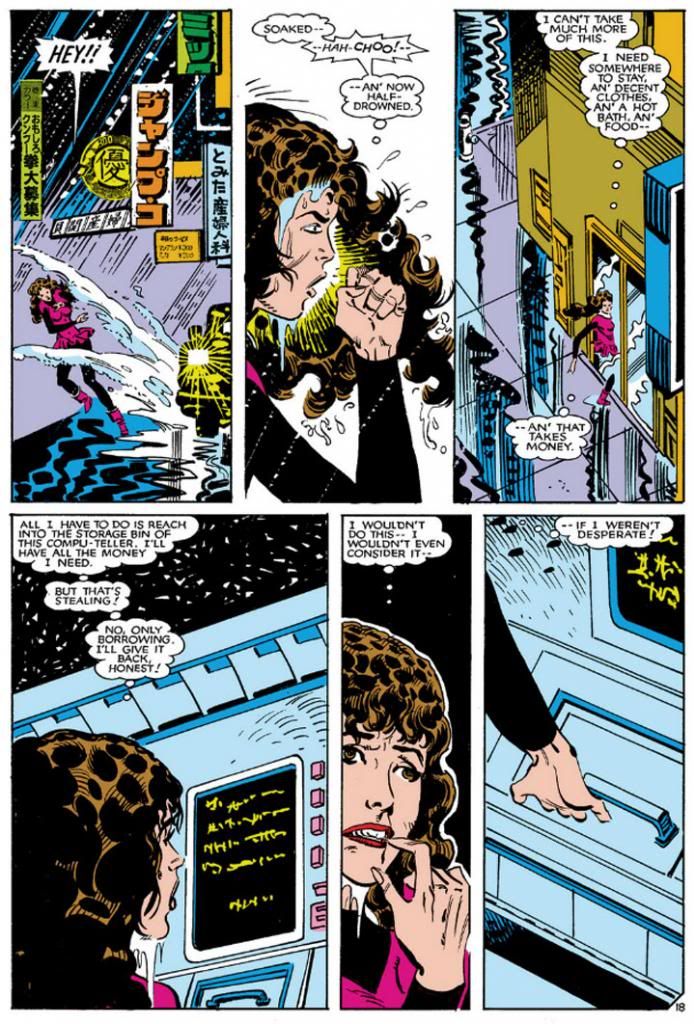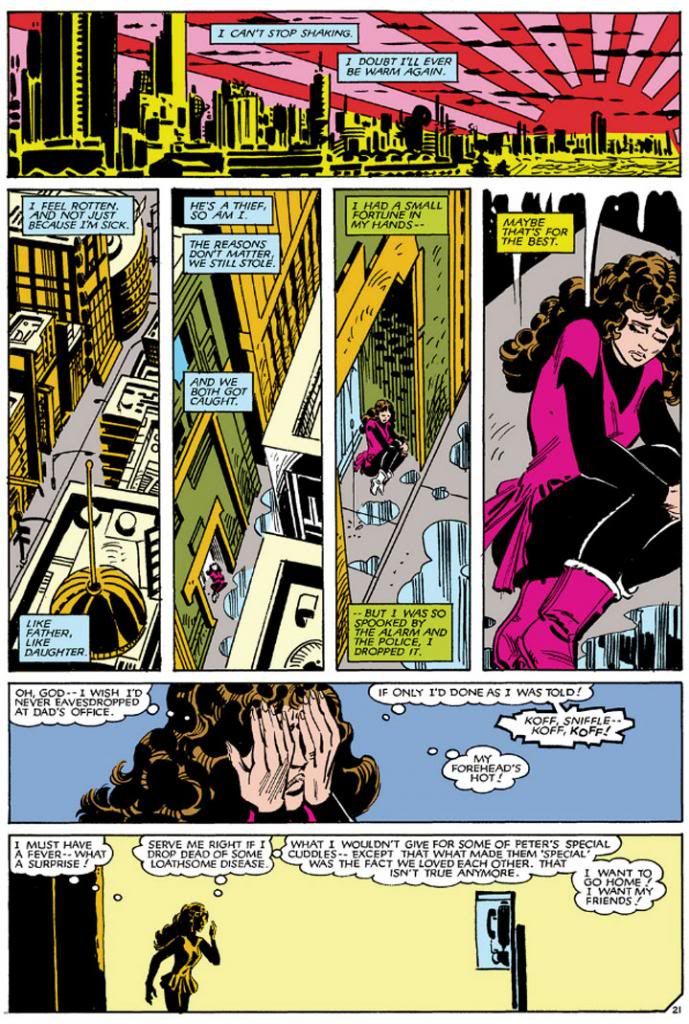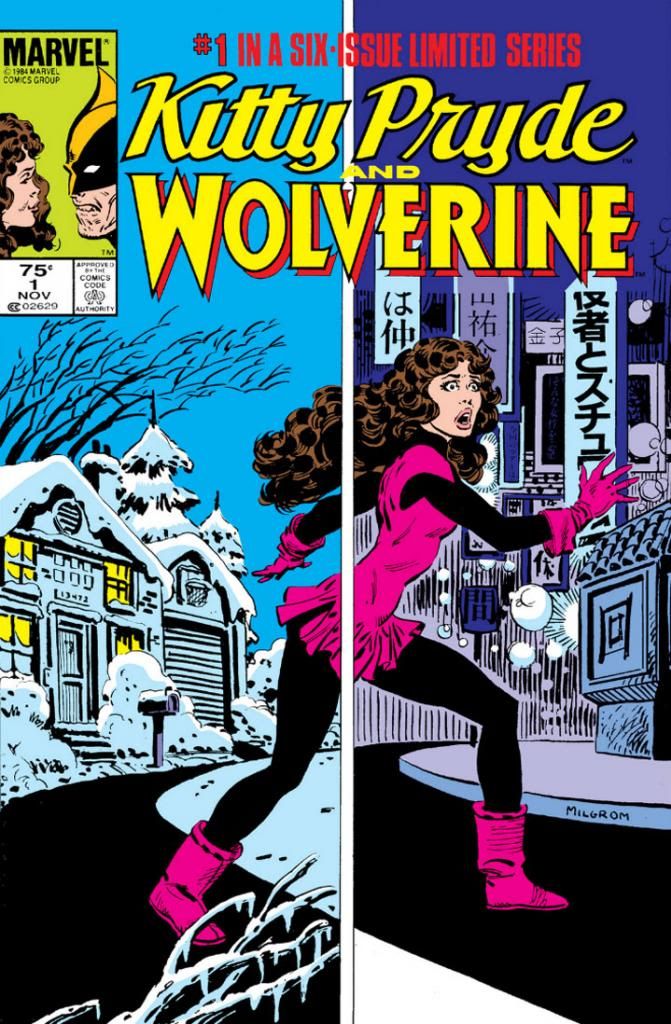Marvel Japan! I can't know for certain (since I wasn't working for them), but I get the feeling Japan was Marvel's go-to country for remaking characters back in the 1980s. In their classic and influential 1982 Wolverine mini-series, Chris Claremont and Frank Miller sent Wolverine there, tore him apart, put him back together again and cemented his place as one of Marvel's top draws. Along the way, they created a fabulous fantasy Japan (we've discussed this already), where the high-tech marvels of modern Tokyo form a backdrop for a lot of pseudo-mystical martial arts tough guy nonsense. In the Marvel Japan Claremont and Miller invoked you could still encounter hordes of ninja and stoic old people still living the ways of bushido in their ancestral castles. It's silly, but it's the best kind of silly. I dug it, you dug it, lots of people dug it, so much so this story recently formed the basis for The Wolverine (in Japan it's called Wolverine: Samurai) starring Hugh Jackman.
In Kitty Pryde and Wolverine (November 1984-April 1985), it's Kitty Pryde's turn to visit Japan and experience life-changing events. And you couldn't ask for a better protagonist, or one more in need of a fresh start than 1984 Kitty Pryde. Lovingly written here by Claremont, our heartbroken yet smart'n'spunky (TM) Kitty is plenty interesting on her own to have headlined a two or three issue romp through 1980s-era Tokyo, capital of a country then enjoying a huge resurgence in economic prowess, self-confidence and cultural energy-- Shinjinrui! Visual kei! Para Para! With New Wave artists already appropriating its looks and imagery, Japan's youth culture stood poised to conquer the pop culture world, and this could have provided plenty of material without anyone resorting to martial arts clichés. Instead, in the second issue, Wolverine muscles his hairy way into the plot and the series becomes a deadly serious remake of his solo story, only with Kitty fighting ninja and yakuza for redemption. Those aspects just don't provide the same kick or appeal the second time around.
But rather than shoot my figurative BB gun at a comic for not doing what I want it to do, I'd rather focus a positive spotlight on the way-cool first issue, which has Kitty lost in translation all by herself, desperately in over her head. So let's take a long, loving look at Kitty Pryde and Wolverine #1. How do Claremont and artist Al Milgrom depict Japan? Is it believable? Does it make a reader feel as if he or she has been there? That's what you're asking me right now, isn't it?
No? Well, okay! I'll tell you anyway!
First, there's the trip journey itself. To get to Tokyo, Kitty stows aboard a JAL flight from Chicago, and I can promise you there absolutely is such a flight, known as JAL Flight 9. These days, the aircraft flying the route is a Boeing 777-300ER, but Kitty hops a 747-400 (I think). That's the same plane I took, only I didn't phase onto it through the cargo bay. I had a ticket, so my arrival at Narita Airport was a lot smoother (and drunker, thanks to JAL's liberal free drinks policy at the time) than Kitty's. Not having my good luck, Kitty then spends a page or so escaping Narita. Today's Narita doesn't look much like the one Milgrom draws, but I first visited it some twenty years after Kitty, so it probably underwent a renovation or two in the interim. Oh, there's a funny bit where Kitty phases onto a bus and accidentally slaps a salaryman on the ass as she solidifies. Today we're more likely to get to Tokyo proper by way of the Narita Express, because Narita is actually way out in the rice fields of rural Chiba prefecture, a fair distance from the urban neighborhoods the where the rest of the story takes place.
Now we come to the meat of this post: Tokyo. Godzilla's Stomping Ground. Where the Bears played the Japanese Little League champs. Kitty visits Tokyo in winter and let me tell you-- Japanese winters are cold! Cold and windy! Because her trip is on the spur of the moment with no time to pack or dress more appropriately, Kitty's skater costume is cute but hardly practical for running around outdoors here. And to top it off, she gets soaked by the rain.
 |
| Script by Chris Claremont, art by Al Milgrom |
Claremont's Kitty may be impulsive at times due to her youth and naiveté, but she's also a thinker. During this sequence, she's sizing up her situation after receiving a pretty heavy duty system shock and already figuring out not only has she made a sizable error in judgment trying to help her dad, she'll also be lucky just to stay out of jail herself. Then the weather takes a dump on her, too. It actually rains a lot in Japan (while Kitty can't because she lacks money, less desperate visitors should buy a cheap umbrella at a convenience store; the wind's just going to destroy an expensive one anyway), so this vaguely Blade Runner-esque cityscape looks pretty accurate. Milgrom inks his pencils with a bold, energetic line and spends more time on the rain shower than the surroundings, but those squiggly blacks Kitty's running across are reasonable visual shorthand for the wet streets and reflective lighting of a rainy Tokyo evening. The vertical signage creates a convincing Tokyo look as well.
In the next sequence, the rain lets up a little so Milgrom shows us more of the city.
 |
| Claremont, Milgrom |
It looks as though Milgrom uses some paste-up lettering here, possibly clipped from Japanese newspapers or magazines, or even actual photos of Tokyo. That's a smart idea. All that lettering would have been a pain for either him or the book's letterer to recreate, and they would have had to hire a translator to make sure they weren't just slapping down squiggles and squares or accidentally writing something rude. Plus, Japanese comic book artists sometimes paste up entire pre-drawn backgrounds from special manga-tool artbooks, or use half-tone photographs. Milgrom does the last, too, but I forgot to capture a screen image of it so you'll just have to take my word here.
Milgrom's version of a Japanese ATM is fun. Since it's the 1980s, Kitty can't quite decide what to call it. "Compu-teller," huh? Now you find ATMs all over the place in Japan-- in banks, post offices, malls and convenience stores. Inconveniently, some of them are not open 24 hours so sometimes you have to be prepared to wait until business hours the next day to withdraw money. Imagine Kitty's dilemma here when she needs cash, it's after hours... and she doesn't have an ATM card or even a bank account.
Don't do it, Kitty! Don't steal that money! Not only is it illegal, but it's also not worth the guilty feelings and depression!
Milgrom waits until almost the end of the issue to give us a widescreen Tokyo cityscape.
 |
| Claremont, Milgrom |
Ah! The "Rising Sun" motif! How Buckaroo Banzai, baby! Now we really know we're in 1980s Japan. Milgrom enjoyed this effect so much he used it again in the fourth issue, rising behind a Japanese castle. After a spectacular overview of the big city, Milgrom zooms in on a neighborhood, finding a sick and miserable Kitty huddles in a doorway. And she hasn't even hit bottom yet. Kitty's back alley/sidestreet hideaway in the second panel tier looks reasonable to me. Granted I spend most of my time in the hip, upscale districts hobnobbing with trendsetting fashionistas like Chiaki Kuriyama and Kyary Pamyu Pamyu, but I've occasionally glanced at just these kinds of lowly city spaces as we've swept by in our motorcycle-escorted limousine motorcades. That pay phone looks pretty generic, but a phone is a phone, I guess.
"I can't stop shaking. I doubt I'll ever be warm again." I get the feeling Chris Claremont visited Japan himself some winter prior to writing this. Anyway, welcome to a country where few buildings feature insulation or central heating even now. Think how rare that must have been almost thirty years ago when Kitty came. These days, I pile on the layers starting with Uniqlo Heat-Tech and ending with a quilted hanten, and my wife and I run an electric heater in the mornings when we get up. I still shiver all winter. And Kitty spent the night outdoors with only her wet skater dress and some tights to protect her. She also swam through a sewer pipe a few hours before. No wonder she's in no mood to enjoy the sunrise.
The rest of the mini-series stages fights inside office buildings or on rooftops (Tokyo Tower makes a background appearance as Wolverine's friend and sometimes lover Yukio dangles an unfortunate oaf over the distant street) and martial arts training sessions at secluded castles right out of Akira Kurosawa flicks. Claremont and Milgrom score high marks on the Japan scene-setting throughout, and while I wish they had kept things Kitty-centric and lighthearted, at least she comes out of it with a spiffy new costume (a softer version of a leather outfit she wears as part of a disguise later in the story), some boss fighting skills and a grown-up codename: Shadowcat.
She does get an ugly New Wave haircut, though.


No comments:
Post a Comment